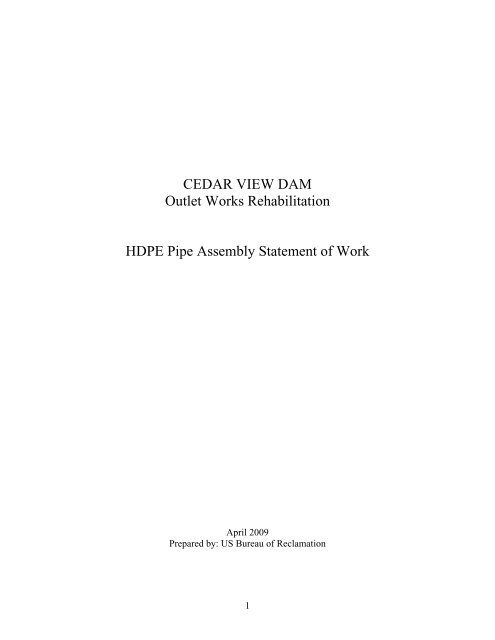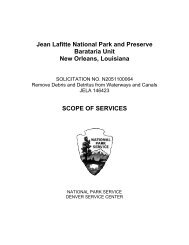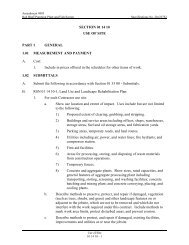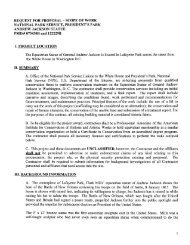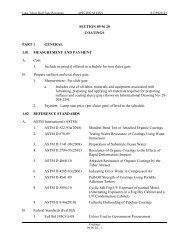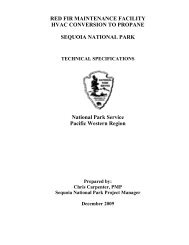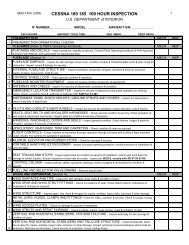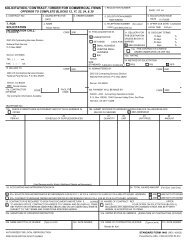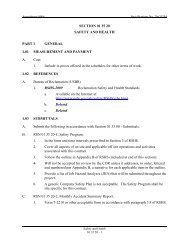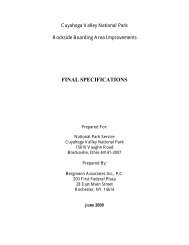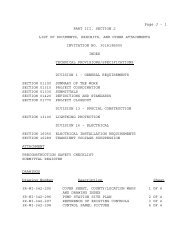HDPE Pipe Assembly Statement of Work - IDEAS-EC
HDPE Pipe Assembly Statement of Work - IDEAS-EC
HDPE Pipe Assembly Statement of Work - IDEAS-EC
You also want an ePaper? Increase the reach of your titles
YUMPU automatically turns print PDFs into web optimized ePapers that Google loves.
CEDAR VIEW DAM<br />
Outlet <strong>Work</strong>s Rehabilitation<br />
<strong>HDPE</strong> <strong>Pipe</strong> <strong>Assembly</strong> <strong>Statement</strong> <strong>of</strong> <strong>Work</strong><br />
April 2009<br />
Prepared by: US Bureau <strong>of</strong> Reclamation<br />
1
<strong>HDPE</strong> <strong>Pipe</strong> <strong>Assembly</strong> <strong>Statement</strong> <strong>of</strong> <strong>Work</strong><br />
BACKGROUND<br />
Cedar View Dam is an <strong>of</strong>f stream reservoir that was originally constructed to provide irrigation<br />
storage for downstream farms. The reservoir was transferred from the irrigators to the Ute<br />
Indian Tribe in the 1960s and the dam crest was raised approximately 15-feet, to the present top<br />
elevation <strong>of</strong> 8036. No drawings can be found for the 1960s changes. A downstream berm was<br />
also added at that time to allow for the additional height <strong>of</strong> the dam. Rudimentary investigation<br />
information has been found, as well as limited original drawings. Actual dam construction<br />
differed from the original drawings in that the outlet gate is located downstream <strong>of</strong> the dam axis,<br />
rather than at the upstream inlet as shown on the original drawings. A square concrete outlet<br />
pipe extension was constructed in the 1960s to allow construction <strong>of</strong> the downstream beam. No<br />
information has been found on the borrow source for the dam. Hydraulic height <strong>of</strong> the existing<br />
dam is approximately 32-feet.<br />
The Ute Indian Tribe has asked Reclamation to minimize the seepage out <strong>of</strong> the reservoir<br />
through the basin and dam to maintain water levels for recreation and fish habitat. Cedar View<br />
Dam is currently used for recreation by the Ute Indian Tribe.<br />
The reservoir was drained in August 2008 to begin rehabilitation <strong>of</strong> the dam and expose the<br />
outlet works. Upon examination <strong>of</strong> the outlet works it was concluded that due to the deteriorated<br />
condition <strong>of</strong> the original concrete encased corrugated metal pipe the conduit needed to be sliplined<br />
with <strong>HDPE</strong> pipe, and the annular space grouted.<br />
SITE LOCATION<br />
Cedar View Dam is located northwest <strong>of</strong> the towns <strong>of</strong> Neola and Roosevelt, Utah in the central<br />
area <strong>of</strong> the south side <strong>of</strong> the High Uinta Mountains. The dam sits between Cottonwood Creek<br />
and the Uinta River drainages, at latitude 40°33’18.15”, Longitude 110°8’0.41”. Figure 1 shows<br />
the location <strong>of</strong> the Dam and Reservoir feature in relation to Roosevelt.<br />
2
Cedar View Dam<br />
Figure 1 - Cedar View Dam and Reservoir in northeastern Utah with respect to Roosevelt,<br />
Utah. Not to scale.<br />
SUMMARY OF WORK<br />
1. Deliver specified <strong>HDPE</strong> pipe, IPS back-up ring, two 18-inch flanged adaptors, one 18-<br />
inch electr<strong>of</strong>usion couplers, and pipe block centralizers to construction site.<br />
2. Deliver all equipment necessary to assemble <strong>HDPE</strong> to construction site.<br />
3. Assemble <strong>HDPE</strong> outlet conduit.<br />
4. Extrusion weld grout delivery lines as indicated in attachment 3.<br />
5. Extrusion weld pipe block centralizers as indicated in attachment 3.<br />
6. Close-out project.<br />
Note: After each section <strong>of</strong> pipe is welded, the government construction crew will insert a<br />
portion <strong>of</strong> the pipe into the existing outlet pipe, until the <strong>HDPE</strong> extends completely through the<br />
existing concrete encased CMP.<br />
3
<strong>Pipe</strong> Summary Table:<br />
Description Quantity Unit<br />
18-inch ID IPS Backup Ring (ANSI Drilling Straddle Center) 1 Each<br />
18-inch electr<strong>of</strong>usion coupler 1 Each<br />
Main 18-inch <strong>HDPE</strong> DR 32.5 <strong>Pipe</strong> 260 LF<br />
18-inch IPS Fittings Flange Adapter DR 32.5 2 Each<br />
Grout <strong>Pipe</strong> No. 1 – 1.5 inch 230 LF<br />
Grout <strong>Pipe</strong> No. 2 – 1.5 inch 200 LF<br />
Grout <strong>Pipe</strong> No. 3 – 1.5 inch 170 LF<br />
Grout <strong>Pipe</strong> No. 4 – 1.5 inch 140 LF<br />
Grout <strong>Pipe</strong> No. 5 – 1.5 inch 110 LF<br />
Grout <strong>Pipe</strong> No. 6 – 1.5 inch 80 LF<br />
Grout <strong>Pipe</strong> No. 7 – 1.5 inch 50 LF<br />
Grout <strong>Pipe</strong> No. 8 – 1.5 inch 30 LF<br />
Block Centralizers/Skid Plates 144 Each<br />
*<strong>HDPE</strong> pipe shall be single and smooth wall, and pressure rated<br />
1 2<br />
Figure 1 – Example <strong>of</strong> IPS Fittings Flange Adapter<br />
Figure 2 – Example <strong>of</strong> IPS Backup Ring. Bolt holes shall be ANSI Drilling Straddle<br />
Center<br />
4
GENERAL REQUIREMENTS<br />
Safety<br />
Personnel shall adhere to Reclamation’s Safety and Health Standards during the performance <strong>of</strong><br />
the work.<br />
A job hazard safety analysis shall be written for the specific work and reviewed with personnel<br />
working on the job.<br />
Utilities<br />
There are no known utilities near the site.<br />
Use <strong>of</strong> Land<br />
Care shall be taken to limit impact to land adjacent to construction area. Care shall be taken to<br />
limit noise and air pollution on the property. Pollution <strong>of</strong> the land and water from oils, fuel and<br />
other hazardous materials shall be avoided at all costs.<br />
SITEWORK<br />
The site will be cleared and graded by the government to provide necessary work space for pipe<br />
assembly and storage.<br />
SITE ACCESS<br />
Access to the site shall be limited to existing roadways. A permit is required to enter Native<br />
American land. Necessary permits will be provided by the government.<br />
<strong>HDPE</strong> PRESSURE PIPE<br />
<strong>HDPE</strong> pipe shall meet the following specifications<br />
PART 1<br />
GENERAL<br />
1.01 MEASUREMENT AND PAYMENT<br />
A. Measurement: Length along pipe centerline between ends <strong>of</strong> pipe in place.<br />
Continuous through fittings with no allowance for lap at joints.<br />
5
B. Payment: Applicable linear foot price. Includes cost <strong>of</strong> furnishing materials;<br />
manufacturing and assembling pipe; Extrusion welding centralizers and grout<br />
delivery lines: and furnishing warranty bond.<br />
1.02 REFERENCES<br />
A. ASTM International (ASTM)<br />
1. ASTM A 193-06 Standard Specification for Alloy-<br />
Steel and Stainless Steel Bolting Materials for High-<br />
Temperature Service.<br />
2. ASTM A 536-84(2004) Standard Specification for<br />
Ductile Iron Castings.<br />
3. ASTM D 638-03 Standard Test Method for Tensile<br />
Properties <strong>of</strong> Plastics.<br />
4. ASTM D 2657-03 Standard Practice for Heat Fusion<br />
Joining <strong>of</strong> Polyolefin <strong>Pipe</strong> and Fittings<br />
5. ASTM D 2774-04e1 Standard Practice for Underground<br />
Installation <strong>of</strong> Thermoplastic Pressure Piping.<br />
6. ASTM D 3261-03 Standard Specification for Butt Heat<br />
Fusion Polyethylene Plastic Fitting for Polyethylene <strong>Pipe</strong><br />
and Tubing.<br />
7. ASTM D 3350-05 Standard Specification for<br />
Polyethylene Plastics <strong>Pipe</strong> and Fittings Materials.<br />
8. ASTM E 165-02 Liquid Penetrant Examination<br />
9. ASTM F 412-06 Terminology Relating to Plastic<br />
Piping Systems<br />
10. ASTM F 714-06 Standard Specification for<br />
Polyethylene (PE) <strong>Pipe</strong> (SDR-PR) Based on Outside<br />
Diameter.<br />
11. ASTM F 2206-02 Fabricated Fittings <strong>of</strong> Butt-Fused<br />
Polyethylene (PE) Plastic <strong>Pipe</strong>, Fittings, Sheet Stock, Plate<br />
Stock, or Block Stock<br />
B. American Water <strong>Work</strong>s Association (AWWA)<br />
1.03 SUBMITTALS<br />
A. <strong>Pipe</strong> and Fittings:<br />
1. AWWA C906-99 Polyethylene (PE) Pressure <strong>Pipe</strong> and<br />
Fittings, 4 in. (100mm) Through 63 in. (1,575 mm), For<br />
Water Distribution and Transmission<br />
6
B. Fusion procedures:<br />
1. Catalog information confirming pipe, fittings, and other<br />
materials conform to requirements <strong>of</strong> this Section.<br />
1. Fusion temperature.<br />
2. Interface pressure.<br />
3. Cooling time.<br />
C. Equipment data: Submit data for fusion welding equipment.<br />
1.04 QUALIFICATIONS<br />
A. <strong>Pipe</strong> Manufacturer: Listed with Plastic <strong>Pipe</strong> Institute as meeting recipe and<br />
mixing requirements <strong>of</strong> resin manufacturer for resin used to manufacture pipe for<br />
this Project.<br />
B. Person fusing <strong>HDPE</strong> pipe shall be certified under 49 CFR § 192.285, have<br />
minimum <strong>of</strong> 1 year <strong>of</strong> experience with fusing <strong>HDPE</strong> pipe in accordance with<br />
recommendations <strong>of</strong> pipe supplier or fusing equipment supplier.<br />
1.05 DELIVERY, STORAGE, AND HANDLING<br />
A. Prevent damage to pipe and fittings during loading, transporting, unloading,<br />
storing, and laying.<br />
B. Shipping: Do not cut, kink, or otherwise damage pipe during transportation.<br />
C. Maintaining circularity <strong>of</strong> pipe 18 inches in diameter and larger.<br />
1. Before shipping, install internal supports in pipe to<br />
maintain circularity.<br />
2. Supports:<br />
a. Two members at 90 degrees to each other.<br />
b.Minimum member cross section: Nominal 2- by 4-<br />
inches.<br />
3. Place supports at 5 feet from ends <strong>of</strong> each pipe section.<br />
4. Orient support legs in same axis along pipe centerline.<br />
5. Where necessary due to ground conditions, store pipe on<br />
wooden sleepers, spaced suitable and <strong>of</strong> such widths as not<br />
to allow deformation <strong>of</strong> pipe at point <strong>of</strong> contact with<br />
sleeper or between supports.<br />
7
D. Transport fittings with padded bolsters between the pipes. Use heavy padding<br />
under ties.<br />
E. Do not store <strong>HDPE</strong> pipe in unprotected, outside storage for more than 2 years.<br />
PART 2<br />
PRODUCTS<br />
2.01 PIPE<br />
A. <strong>HDPE</strong> Pressure <strong>Pipe</strong>: AWWA C 906, except;<br />
2.02 MATERIALS<br />
1. PE material:<br />
a. Standard PE code designation: PE 3408.<br />
b.Minimum cell Classification, ASTM D 3350: PE<br />
334434C, or E.<br />
A. Polyethylene resin shall meet or exceed requirements <strong>of</strong> ASTM D3350 for PE<br />
3408 material with cell classification <strong>of</strong> 335434C, or better.<br />
B. Maximum Allowable Hoop Stress: 800 psi at 73.4 degrees F.<br />
C. <strong>Pipe</strong> sizes shall conform to ASTM F714.<br />
D. <strong>Pipe</strong> and fittings shall have a Standard Dimension Ratio (SDR) as shown on the<br />
Drawings.<br />
2.03 THERMAL BUTT FUSION<br />
A. <strong>Pipe</strong> lengths, fittings, and flanged connections to be joined by thermal butt-fusion<br />
shall be <strong>of</strong> same type, grade, and class <strong>of</strong> polyethylene compound and supplied<br />
from same raw material supplier.<br />
2.04 FITTINGS<br />
A. Tees, crosses, tapers, adaptors, couplings, bends, and connections at structures<br />
and encasements: Fabricated from <strong>HDPE</strong> for sizes 8 inch and larger, by means <strong>of</strong><br />
thermal butt-fusion. Ends <strong>of</strong> fabricated fittings shall not be trimmed to match<br />
pipe section to which they are going to be joined. Polyethylene fittings shall have<br />
same or higher pressure rating as pipe when installed, unless otherwise specified,<br />
or as shown on drawings.<br />
B. <strong>HDPE</strong> fittings: In accordance with AWWA C906, ASTM F 2206, and as shown<br />
on drawings.<br />
1. Material: PE3408.<br />
8
C. Metal back-up flange:<br />
2.05 SOURCE QUALITY CONTROL<br />
1. Material: Ductile iron, Class 150, ANSI B16.1/B16.5, coat<br />
in accordance with manufacturer’s recommendation.<br />
A. <strong>HDPE</strong> Fittings:<br />
1. Test <strong>HDPE</strong> fittings in accordance with AWWA C906.<br />
2.06 QUALITY ASSURANCE<br />
A. Acceptance <strong>of</strong> material delivered to the site shall be subject to approval by the<br />
government.<br />
PART 3<br />
EX<strong>EC</strong>UTION<br />
3.01 PIPE ASSEMBLY<br />
A. Joining <strong>Pipe</strong>:<br />
1. Make heat fusion joint in accordance with<br />
recommendations <strong>of</strong> ASTM D 2657 using a Data Logger to<br />
record activity.<br />
2. <strong>Pipe</strong> shall be joined completely prior to insertion <strong>of</strong> any<br />
part into the existing conduit. <strong>Pipe</strong> shall be supported and<br />
handled in a manner that prevents damage.<br />
3. After joining operations are completed clean inside <strong>of</strong> pipe<br />
and remove debris.<br />
3.02 EXTRUSION WELDING<br />
A. Welding Conduit Centralizers and Grout Delivery Feed Lines.<br />
1. Weld conduit centralizers and grout delivery feed lines in<br />
accordance with recommendations <strong>of</strong> ASTM D 3261.<br />
3.03 TESTING AND INSP<strong>EC</strong>TION<br />
A. All heat fusion joints to be recorded on a data logger and results given to<br />
Contracting Officer’s Representative.<br />
B. Joint and Mandrel Testing:<br />
1. Joint:<br />
a. Test Procedure: ASTM D638<br />
9
2. Mandrel:<br />
b.Specimens: Cut pipe 12 inches on each side <strong>of</strong> field<br />
made joint. Rejoin ends and proceed with <strong>Work</strong><br />
c. Test Frequency:<br />
1) One joint selected at random by Contracting<br />
Officer’s Representative.<br />
2) Each Test Failure: Two additional joints<br />
selected at random by Contracting Officer’s<br />
Representative.<br />
a. Mandrel test pipeline.<br />
b.Mandrel Configuration: Rigid, with circular crosssection<br />
<strong>of</strong> diameter not less than 92 percent <strong>of</strong><br />
average inside diameter <strong>of</strong> pipeline and with length<br />
<strong>of</strong> circular portion equal to nominal diameter <strong>of</strong><br />
pipeline.<br />
c. Pulling Method: Manually, by hand.<br />
PROJ<strong>EC</strong>T CLOSEOUT<br />
Remove all equipment from construction site. Remove excess pipe and other pipe assembly<br />
related debris.<br />
ATTACHMENTS<br />
Attachment 1 – Dam and Spillway Plan<br />
Attachment 2 – Maximum Embankment Cross-Section<br />
Attachment 3 – Grout Delivery Line Orientation and Slip-Line Details<br />
10


